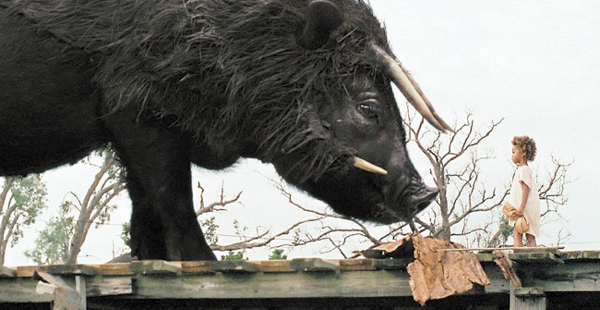Movie review by Greg Carlson
Memorable and stirring, “Beasts of the Southern Wild” snaked through the Sundance Institute screenwriting, producing, and directing labs on its way to some of the best reviews of the year and the Camera d’Or at Cannes. Overwhelming critical support, however, has not prevented several pointed jabs at filmmaker Benh Zeitlin’s debut feature from writers skeptical of a white director’s treatment of black characters. Richard Brody and A.O. Scott tangled in a Twitter skirmish that Roger Ebert re-posted as a screen cap on Facebook, and their arguments effectively summarize the film’s resistance to one interpretation. Like many great stories, “Beasts of the Southern Wild” invites reflection.
Whether one believes Zeitlin’s film subverts stereotypes or perpetuates them, there is no question that “Beasts of the Southern Wild” treats its characters with a reverence that emphasizes attributes frequently associated with cinematic traditions and conventions surrounding the poor and the black. For Brody, and for Tim Grierson of “Deadspin,” Zeitlin teeters into condescension by patronizing and oversimplifying the inhabitants of the Bathtub, the bayou setting where the ghost of Hurricane Katrina looms large without ever being identified by name. This cynical reading, however, will surprise anyone who embraces the irrepressible heart and spirit of central protagonist Hushpuppy (Quvenzhane Wallis), a six-year-old navigating the treacherous depths of her father Wink’s (Dwight Henry) encroaching, terminal illness.
Based on the one act play “Juicy and Delicious” by Lucy Alibar, who co-wrote the film adaptation with Zeitlin, “Beasts of the Southern Wild” takes a deep interest in the ideas of home and family. In a “Film Comment” interview with Scott Foundas, Zeitlin describes his desire to understand why people would choose to stay in a precarious place made all the more dangerous by an overwhelming natural disaster. The element of mandatory evacuation orders from government authorities sounds an additional thematic note that powerfully alludes to ways in which self-identity can be threatened by agents in positions of power. The residents of the Bathtub share a raucous camaraderie, bonhomie, and loyalty to community and the social body.
Hushpuppy’s poetic voiceover immediately conjures the haunted, preternatural, non sequitur-heavy wisdom of Linda Manz’s similar musings in Terrence Malick’s “Days of Heaven,” and Zeitlin’s interest in elliptical expression and reliance on image over dialogue invite a positive comparison to the master filmmaker whose “The Tree of Life” reaches out to ask some of the same massive questions about the very nature of existence through the vessel of a young child. Because Hushpuppy is too young to articulate her thoughts with the logic and detachment that comes with adulthood, the viewing experience is filtered through her imagination in the contours of magical realism furnished by the grain of Ben Richardson’s 16mm photography.
Wallis delivers the kind of performance that instantly ranks with several of the cinema’s most memorable turns by the very young, including Victoire Thivisol in “Ponette” and Ana Torrent in “The Spirit of the Beehive.” In one critical motif, Hushpuppy prepares for the arrival of monstrous aurochs. All the wonder contained in the extinct, primitive ancestor of cattle (seen in the film as horned and tusked pigs), and imagined by Hushpuppy and the filmmakers as omens of the anxious unknown, is perfectly realized via a combination of inventive costuming, puppetry, forced perspective, and green screen photography. Spike Lee’s “When the Levees Broke” remains the definitive cinematic document of the Katrina catastrophe, but “Beasts of the Southern Wild” makes a worthy fictional companion.
